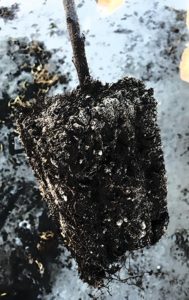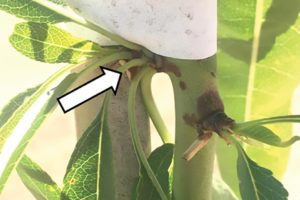Tips For Late-Planting Potted Almond Trees
Historically, the establishment of deciduous orchards was typified by planting bare-rooted trees during dormancy. With the advent of technology and the demand for rapid turn-around times, more growers are turning to the use of container-propagated potted trees. Bare-rooted trees still account for the majority of new plantings, but the use of potted trees, which are planted during all 12 months of the year, have some singular demands.

Ensuring adequate moisture of a potted tree root post-planting is critical. (Photo credit: Wes Asai)
Most of the time when a potted tree is planted, it is leafed-out and actively growing. This presents a special demand for keeping the trees hydrated since their water use is ongoing from the moment they arrive for planting. This is especially critical for hybrid rootstocks, which can be more sensitive to dehydration. While keeping the trees watered before and at planting is important, the days after are the most critical, especially until the roots develop outside of the peat/vermiculite square they were propagated in.
Due to the poor hydraulic conductivity between the root square and the soil interface, oftentimes the soil around the new planting may be moist, while the root mass is dry. It is important to monitor the status of the root square. Some growers will lightly break up the rooting mass at planting to allow the roots a more intimate contact with the native soil. Even with this method, ensuring adequate moisture post-planting is critical.
Other factors commonly encountered when potted trees are planted late into the growing season are developmental. These may include factors such as the number of buds that break into branches, the orientation of the breaks, the caliper of the trunks, and insect pests.
When large caliper (greater than ¾-inch) trees are planted during dormancy, they can be treated similarly to bare-rooted trees. Small caliper trees that sometimes are thinner than ¼-inch, or trees planted in the heat of summer, present the greater challenges.

This bamboo stake can inhibit branch development. (Photo credit: Wes Asai)
Assuming that root moisture is correctly managed with frequent light irrigations until root establishment, bud development is the next most critical factor. If the trees are planted in the latter third of the year, and seasonal growth is poor, it may be better to trim back all new growth at the end of the season back to the main trunk and allow new scaffolds to develop similar to a dormant bare-rooted tree. Since the roots are already established, the tree will take off rapidly the following spring and offer good scaffold selections.
When extremely thin caliper trees are used, they cannot stand on their own without the assistance of the bamboo stake. Care is needed to prevent a tight band from inhibiting proper branch development and angles.
Also, smaller trees tend to have a dominant central leader that can cause the tree to be pyramid-shaped (rather than vase) and require the creation of a large disease-susceptible pruning wound in the center top of the scaffold during first scaffold selection. To prevent this, the central leader can be removed during early development.
In the other extreme, when large caliper trees are received, sometimes the result of over-mature root-bound trees from a cancelled order, bud

A dominant central leader can form on smaller trees, causing a pyramid shape. (Photo credit: Wes Asai)
selection for scaffolds can be very poor. It is not uncommon for trees of this stature to have 100% of the scaffolds push from only the top of the tree, creating an unbalanced tree with a weak crotch structure.
In other cases, all of the branches may break only in one direction, typically downwind, also creating an unbalanced tree. In these situations, it is often better to cut back all growth to the main trunk, similar to a dormant planted bare-rooted tree and force new breaks directly from the trunk.
Once late-planted trees are established and new buds are pushing, insect management is more important than with early planted trees. The first generation of peach twig borer needs to be controlled so they do not strike the new tender bud breaks.
Also, late planted trees have a large percentage of their new terminal growth developing during a period where there is high thrips activity. As nurseries can attest, severe thrips damage can stunt trees and cause undesirable side-branching at this time.










